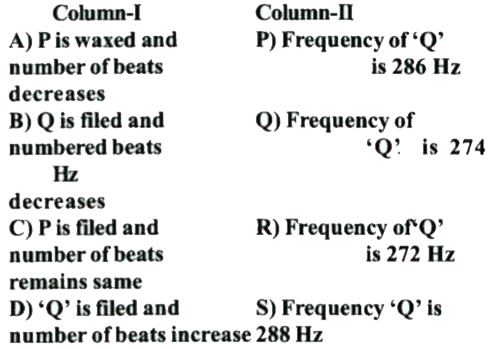A tuning fork having n = 158 Hz, produce 3 beats/s with another. As we file the arm of unknown, beats become 7 then calculate the frequency of unknown.
To solve the problem step by step, we will follow the reasoning laid out in the video transcript.
1. Identify the Known Frequency:
The frequency of the tuning fork is given as:
n1=158 Hz
2. Determine the Initial Beat Frequency:
Initially, the tuning fork produces 3 beats per second with an unknown frequency n2. The beat frequency is given by the absolute difference between the two frequencies:
|n1−n2|=3
This leads to two possible equations:
n2=n1+3orn2=n1−3
Substituting the known frequency:
n2=158+3=161 Hzorn2=158−3=155 Hz
3. Filing the Arm of the Unknown Fork:
When the arm of the unknown fork is filed, its frequency increases. As a result, the beat frequency increases to 7 beats per second:
|n1−n′2|=7
Here, n′2 is the new frequency of the unknown fork after filing.
4. Determine the New Frequency of the Unknown Fork:
Since filing increases the frequency, we can consider both cases for n2 (either 161 Hz or 155 Hz) and see which one leads to a valid solution:
- Case 1: If n2=161 Hz:
|158−n′2|=7
This gives:
n′2=158+7=165 Hzorn′2=158−7=151 Hz
Here, n′2=165 Hz is valid since it is greater than 161 Hz.
- Case 2: If n2=155 Hz:
|158−n′2|=7
This gives:
n′2=158+7=165 Hzorn′2=158−7=151 Hz
Here, n′2=151 Hz is not valid since it is less than 155 Hz.
5. Conclusion:
The only valid solution for the frequency of the unknown fork after filing is:
n′2=151 Hz
Final Answer:
The frequency of the unknown tuning fork is:
151 Hz
The frequency of the tuning fork is given as:
n1=158 Hz
Initially, the tuning fork produces 3 beats per second with an unknown frequency n2. The beat frequency is given by the absolute difference between the two frequencies:
|n1−n2|=3
This leads to two possible equations:
n2=n1+3orn2=n1−3
Substituting the known frequency:
n2=158+3=161 Hzorn2=158−3=155 Hz
When the arm of the unknown fork is filed, its frequency increases. As a result, the beat frequency increases to 7 beats per second:
|n1−n′2|=7
Here, n′2 is the new frequency of the unknown fork after filing.
Since filing increases the frequency, we can consider both cases for n2 (either 161 Hz or 155 Hz) and see which one leads to a valid solution:
- Case 1: If n2=161 Hz:
|158−n′2|=7
This gives:
n′2=158+7=165 Hzorn′2=158−7=151 Hz
Here, n′2=165 Hz is valid since it is greater than 161 Hz.
|158−n′2|=7
This gives:
n′2=158+7=165 Hzorn′2=158−7=151 Hz
Here, n′2=151 Hz is not valid since it is less than 155 Hz.
The only valid solution for the frequency of the unknown fork after filing is:
n′2=151 Hz
The frequency of the unknown tuning fork is:
151 Hz
Topper's Solved these Questions
Similar Questions
A tuning fork having n = 300 Hz produces 5 beats/s with another tuning fork. If impurity (wax) is added on the arm of known tuning fork, the number of beats decreases then calculate the frequency of unknown tuning fork.
View SolutionTwo tuning forks when sounded together produce 4 beats per second. The first produces 8 beats per second. Calculate the frequency of the other.
View Solution
Knowledge Check
- Question 1 - Select One
A tuning fork 'P' of frequency 280Hz produces 6 beats/s with unknown tuning fork 'Q'
 AABCDQRSRBABCDQRQPCABCDP.QQ.RR.SPDABCDR.SQ.RSR
AABCDQRSRBABCDQRQPCABCDP.QQ.RR.SPDABCDR.SQ.RSR - Question 2 - Select One
Tuning fork A of frequency 205 Hz produces 5 beats/sec with another fork B. After filing the tuning fork B, it produces 3 beats/sec with A. What was the frequency of the fork B before filling?
A310 HzB313 HzC308 HzD300 Hz - Question 3 - Select One
A tuning fork A produces 4 beats/sec with another tuning fork B of frequency 320 Hz . On filing the fork A , 4 beats/sec are again heard. The frequency of fork A , after filing is
A324 HzB320 HzC316 HzD314 Hz
A tuning fork of frequency of 512Hz when sounded with unknown tunning fork produces 5 beats/sec. If arms of the unknown fork are filed then it produces only 3 beats/sec. Find the frequency of unknown tunning fork.
View SolutionA tuning fork A produces 5 beats/sec with another tuning fork B of frequency 256 Hz. If tuning fork A produces 1 beats/sec with some other tuning fork C of frequency 250 Hz, then calculate the frequency of fork A.
View SolutionFrequency of tuning fork A is 256 Hz. It produces 4 beats/second with tuning fork B. When wax is applied at tuning fork B then 6 beats/second are heard. Frequency of B is :-
View SolutionA tuning fork A of frequency 512 Hz sounded with another tuning fork B gives 5 beats/sec. On loading B with a piece of wax, and on sounding, again 5 beats/sec are produced. Calculate the frequency of fork B.
View SolutionTwo tuning forks A and B produce 8 beat/s when sounded together. When B is slightly loaded with a wax the beats are reduced to 4 per sec. If the frequency of A is 512 Hz, the frequency of B is
View Solution

